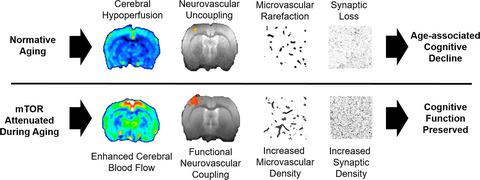当前位置:
X-MOL 学术
›
Aging Cell
›
论文详情
Our official English website, www.x-mol.net, welcomes your feedback! (Note: you will need to create a separate account there.)
mTOR drives cerebrovascular, synaptic, and cognitive dysfunction in normative aging.
Aging Cell ( IF 7.8 ) Pub Date : 2019-11-06 , DOI: 10.1111/acel.13057 Candice E Van Skike 1, 2 , Ai-Ling Lin 3 , Raquel Roberts Burbank 1 , Jonathan J Halloran 1 , Stephen F Hernandez 1, 2 , James Cuvillier 1, 2, 4 , Vanessa Y Soto 1 , Stacy A Hussong 1, 4 , Jordan B Jahrling 1 , Martin A Javors 5 , Matthew J Hart 1, 6, 7 , Kathleen E Fischer 8 , Steven N Austad 8 , Veronica Galvan 1, 2, 4
Aging Cell ( IF 7.8 ) Pub Date : 2019-11-06 , DOI: 10.1111/acel.13057 Candice E Van Skike 1, 2 , Ai-Ling Lin 3 , Raquel Roberts Burbank 1 , Jonathan J Halloran 1 , Stephen F Hernandez 1, 2 , James Cuvillier 1, 2, 4 , Vanessa Y Soto 1 , Stacy A Hussong 1, 4 , Jordan B Jahrling 1 , Martin A Javors 5 , Matthew J Hart 1, 6, 7 , Kathleen E Fischer 8 , Steven N Austad 8 , Veronica Galvan 1, 2, 4
Affiliation

|
Cerebrovascular dysfunction and cognitive decline are highly prevalent in aging, but the mechanisms underlying these impairments are unclear. Cerebral blood flow decreases with aging and is one of the earliest events in the pathogenesis of Alzheimer's disease (AD). We have previously shown that the mechanistic/mammalian target of rapamycin (mTOR) drives disease progression in mouse models of AD and in models of cognitive impairment associated with atherosclerosis, closely recapitulating vascular cognitive impairment. In the present studies, we sought to determine whether mTOR plays a role in cerebrovascular dysfunction and cognitive decline during normative aging in rats. Using behavioral tools and MRI‐based functional imaging, together with biochemical and immunohistochemical approaches, we demonstrate that chronic mTOR attenuation with rapamycin ameliorates deficits in learning and memory, prevents neurovascular uncoupling, and restores cerebral perfusion in aged rats. Additionally, morphometric and biochemical analyses of hippocampus and cortex revealed that mTOR drives age‐related declines in synaptic and vascular density during aging. These data indicate that in addition to mediating AD‐like cognitive and cerebrovascular deficits in models of AD and atherosclerosis, mTOR drives cerebrovascular, neuronal, and cognitive deficits associated with normative aging. Thus, inhibitors of mTOR may have potential to treat age‐related cerebrovascular dysfunction and cognitive decline. Since treatment of age‐related cerebrovascular dysfunction in older adults is expected to prevent further deterioration of cerebral perfusion, recently identified as a biomarker for the very early (preclinical) stages of AD, mTOR attenuation may potentially block the initiation and progression of AD.
中文翻译:

mTOR 在正常衰老过程中驱动脑血管、突触和认知功能障碍。
脑血管功能障碍和认知能力下降在衰老过程中非常普遍,但这些损伤背后的机制尚不清楚。脑血流量随着年龄的增长而减少,是阿尔茨海默病 (AD) 发病机制中最早的事件之一。我们之前已经表明,雷帕霉素 (mTOR) 的机制/哺乳动物靶标在 AD 小鼠模型和与动脉粥样硬化相关的认知障碍模型中驱动疾病进展,密切概括血管认知障碍。在本研究中,我们试图确定 mTOR 是否在大鼠正常衰老期间的脑血管功能障碍和认知能力下降中发挥作用。使用行为工具和基于 MRI 的功能成像,以及生化和免疫组织化学方法,我们证明,雷帕霉素慢性 mTOR 衰减可改善学习和记忆缺陷,防止神经血管解偶联,并恢复老年大鼠的脑灌注。此外,海马体和皮层的形态学和生化分析表明,mTOR 在衰老过程中导致突触和血管密度与年龄相关的下降。这些数据表明,除了在 AD 和动脉粥样硬化模型中介导 AD 样认知和脑血管缺陷外,mTOR 还驱动与正常衰老相关的脑血管、神经元和认知缺陷。因此,mTOR 抑制剂可能具有治疗与年龄相关的脑血管功能障碍和认知能力下降的潜力。由于治疗老年人与年龄相关的脑血管功能障碍有望防止脑灌注进一步恶化,
更新日期:2019-11-06
中文翻译:

mTOR 在正常衰老过程中驱动脑血管、突触和认知功能障碍。
脑血管功能障碍和认知能力下降在衰老过程中非常普遍,但这些损伤背后的机制尚不清楚。脑血流量随着年龄的增长而减少,是阿尔茨海默病 (AD) 发病机制中最早的事件之一。我们之前已经表明,雷帕霉素 (mTOR) 的机制/哺乳动物靶标在 AD 小鼠模型和与动脉粥样硬化相关的认知障碍模型中驱动疾病进展,密切概括血管认知障碍。在本研究中,我们试图确定 mTOR 是否在大鼠正常衰老期间的脑血管功能障碍和认知能力下降中发挥作用。使用行为工具和基于 MRI 的功能成像,以及生化和免疫组织化学方法,我们证明,雷帕霉素慢性 mTOR 衰减可改善学习和记忆缺陷,防止神经血管解偶联,并恢复老年大鼠的脑灌注。此外,海马体和皮层的形态学和生化分析表明,mTOR 在衰老过程中导致突触和血管密度与年龄相关的下降。这些数据表明,除了在 AD 和动脉粥样硬化模型中介导 AD 样认知和脑血管缺陷外,mTOR 还驱动与正常衰老相关的脑血管、神经元和认知缺陷。因此,mTOR 抑制剂可能具有治疗与年龄相关的脑血管功能障碍和认知能力下降的潜力。由于治疗老年人与年龄相关的脑血管功能障碍有望防止脑灌注进一步恶化,


























 京公网安备 11010802027423号
京公网安备 11010802027423号